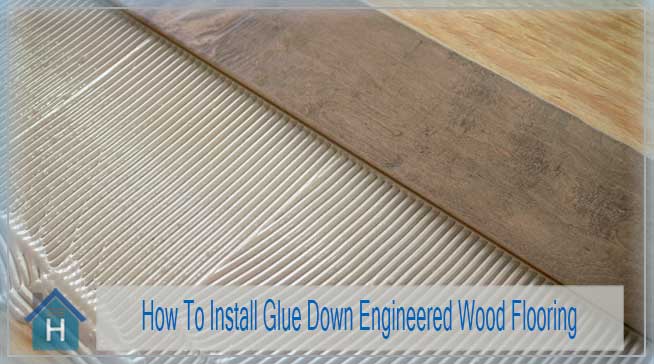Have you ever stared down at a cold, unforgiving concrete floor and dreamt of transforming it into something more inviting? Maybe you envision a warm, wooden floor that welcomes you home after a long day. But your dream is plagued by a nagging question: can you actually glue plywood directly to concrete? The answer, surprisingly, is a resounding yes! But don’t jump into that project without some crucial information. This article will guide you through the process, dispelling myths and offering expert tips to ensure your project is a success.

Image: www.thehomedigs.com
Gluing plywood to concrete is a common practice for various DIY projects and renovations. Whether you’re crafting a custom workspace, transforming a basement, or simply adding a layer of warmth to a bare concrete floor, understanding the intricate details of this process is essential for achieving a sturdy, long-lasting finish.
Understanding The Bond: The Science Behind Adhesion
The seemingly simple action of gluing plywood to concrete is actually a complex dance of molecular forces. To understand why it works, we need to dive into the world of adhesion. Adhesion, in its simplest form, is the force that holds two different materials together. When it comes to gluing plywood to concrete, we’re specifically interested in the adhesive force between the glue, the plywood, and the concrete surface.
The Importance of Surface Preparation
The foundation of a strong bond lies in proper surface preparation. Concrete, by nature, is a porous material. Its surface can harbor dust, debris, and even microscopic particles of grease or oil, all of which act as barriers, preventing the glue from making full contact with the concrete.
To ensure that the glue has a strong foundation to adhere to, you must thoroughly clean and prepare the concrete surface. This involves removing any loose debris, dust, or contaminants. For a more robust bond, consider using a concrete etching solution, a chemical that will roughen the surface, creating microscopic pores for the glue to penetrate.
Choosing the Right Glue
The glue you choose plays a vital role in the success of your project. A good construction adhesive designed for bonding wood to concrete will offer superior adhesion and resistance to moisture and temperature fluctuations.
For best results, choose a glue that is specifically formulated for bonding wood to concrete. Avoid general-purpose glues, as their performance may not be optimal for this application.
Image: www.diynot.com
The Step-By-Step Process: Bringing Your Vision to Life
Now, let’s break down the process of gluing plywood to concrete:
1. Prepare the Concrete Surface:
- Thorough Cleaning: Begin by sweeping or vacuuming the concrete surface to remove dust, debris, and loose particles.
- Etching (Optional): Consider using a concrete etching solution to create a rougher surface, increasing the glue’s adherence.
- Primer (Optional): Priming the concrete can further enhance bonding and prevent moisture from seeping through. Choose a concrete primer specifically formulated for wood adhesion.
2. Measure and Cut the Plywood:
- Accurate Dimensions: Carefully measure the area you wish to cover with plywood.
- Leave a Gap: For proper expansion and contraction, leave a small gap (around 1/4 inch) between plywood sheets.
- Clean the Plywood: Before applying glue, clean the plywood surface with a damp cloth to remove any dust or debris.
3. Apply Glue:
- Use a Construction Adhesive: Select a high-quality construction adhesive designed for bonding wood to concrete.
- Apply in Even Beads: Apply the glue in evenly spaced beads along the underside of the plywood, ensuring sufficient coverage.
- Avoid Excessive Glue: While sufficient glue is essential, applying too much will result in a messy, uneven application and potential bubbles when placing the plywood.
4. Secure the Plywood:
- Place Carefully: Gently place the plywood sheets onto the prepared concrete surface, aligning them accurately.
- Apply Pressure: Apply even pressure across the plywood to ensure good contact with the glue.
- Use Shims (Optional): For uneven concrete, use shims to level the plywood sheets as you apply pressure.
5. Cure Time:
- Allow Adequate Time: Follow the manufacturer’s instructions for cure time. This is the time required for the adhesive to fully harden and achieve its maximum bonding strength.
- Avoid Disturbance: During the curing process, avoid placing any weight or pressure on the plywood to allow the adhesive to fully bond.
Expert Insights for a Successful Project
It’s essential to seek guidance from professionals to take your project to the next level. Here are a few valuable tips from experienced contractors and DIY enthusiasts:
- Consider a Moisture Barrier: For areas prone to moisture, install a moisture barrier beneath the plywood to prevent water damage.
- Stagger Joints: When using multiple sheets of plywood, stagger the joints to provide greater structural integrity.
- Use Screws for Additional Support: In high-traffic areas or if you plan to install heavy furniture, consider adding screws through the plywood and into the concrete for extra support.
Can You Glue Plywood To Concrete Floor
Conclusion: A Strong Foundation for Your Projects
Gluing plywood to concrete opens a world of possibilities for transforming your space. By understanding the essential steps, choosing the right materials, and considering expert advice, you can achieve a successful and long-lasting outcome. Whether you’re creating a workshop, adding a warm touch to your basement, or crafting a custom floor, remember that the key lies in proper preparation, strategic glue selection, and careful execution.






